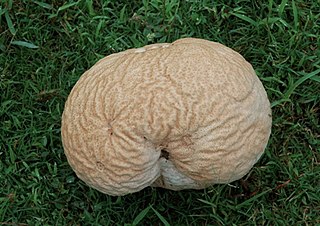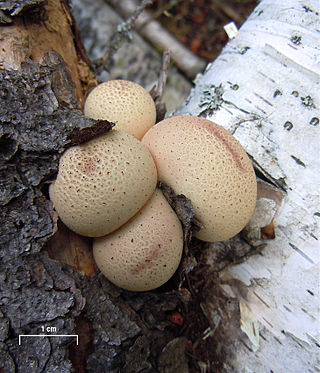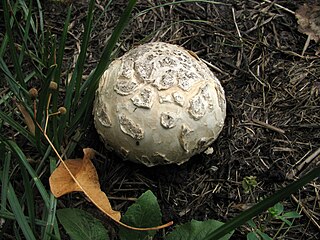
Puffballs are a type of fungus featuring a ball-shaped fruit body that bursts on contact or impact, releasing a cloud of dust-like spores into the surrounding area. Puffballs belong to the division Basidiomycota and encompass several genera, including Calvatia, Calbovista and Lycoperdon. The puffballs were previously treated as a taxonomic group called the Gasteromycetes or Gasteromycetidae, but they are now known to be a polyphyletic assemblage.

Calvatia is a genus of puffball mushrooms that includes the spectacular giant puffball C. gigantea. It was formerly classified within the now-obsolete order Lycoperdales, which, following a restructuring of fungal taxonomy brought about by molecular phylogeny, has been split; the puffballs, Calvatia spp. are now placed in the family Agaricaceae of the order Agaricales.

Calvatia craniiformis, commonly known as the brain puffball or the skull-shaped puffball, is a species of puffball fungus in the family Agaricaceae. It is found in Asia, Australia, and North America, where it grows on the ground in open woods. Its name, derived from the same Latin root as cranium, alludes to its resemblance to an animal's brain. The skull-shaped fruit body is 8–20 cm (3–8 in) broad by 6–20 cm (2–8 in) tall and white to tan. Initially smooth, the skin (peridium) develops wrinkles and folds as it matures, cracking and flaking with age. The peridium eventually sloughs away, exposing a powdery yellow-brown to greenish-yellow spore mass. The puffball is edible when the gleba is still white and firm, before it matures to become yellow-brown and powdery. Mature specimens have been used in the traditional or folk medicines of China, Japan, and the Ojibwe as a hemostatic or wound dressing agent. Several bioactive compounds have been isolated and identified from the brain puffball.

Apioperdon pyriforme commonly known as the pear-shaped puffball or stump puffball, is a saprobic fungus present throughout much of the world. Emerging in autumn, this puffball is common and abundant on decaying logs of both deciduous and coniferous wood. It is considered a choice edible when still immature and the inner flesh is white. It is often called Lycoperdon pyriforme, but was transferred to Apioperdon in 2017 based on phylogenetic and morphological differences. It is the only species in the genus.

Bovista is a genus of fungi commonly known as the true puffballs. It was formerly classified within the now-obsolete order Lycoperdales, which, following a restructuring of fungal taxonomy brought about by molecular phylogeny, has been split; the species of Bovista are now placed in the family Agaricaceae of the order Agaricales. Bovista species have a collectively widespread distribution, and are found largely in temperate regions of the world. Various species have historically been used in homeopathic preparations.

Bovista plumbea, commonly known as the tumbling puffball, tumbleball, or paltry puffball, is a small puffball mushroom commonly found in Western Europe and California, white when young and greyish in age. Easily confused with immature Bovista dermoxantha, it is attached to the substrate by a tuft of mycelium.

Bovista dermoxantha is a small, white, nearly round puffball, recognized when young by a cottony-felty outer surface that becomes inconspicuously warted, eventually leaving fine, pallid, scales on an ochre to brown endoperidium. Bovista plumbea is similar, but has a smoother surface when young, and lacks a basal mycelial cord. In age it is distinguished by a dull greyish endoperidium. Large specimens of Bovista dermoxantha may also be mistaken for Bovista pila. Both have a mycelial cord attachment to the substrate, but Bovista pila differs in releasing spores through tears or splits in the endoperidium rather than by an apical pore.

Bovista aestivalis is a species of small puffball in the family Agaricaceae. It is generally found in the coastal regions of California, but was reported from Korea in 2015. This fungus is often confused with Bovista dermoxantha, because of its similar peridium, and Bovista plumbea. The surest way to tell the species apart is to examine the spores and exoperidium, respectively, with a microscope.

Calvatia sculpta, commonly known as the sculpted puffball, the sculptured puffball, the pyramid puffball, or Sierran puffball, is a species of puffball fungus in the family Agaricaceae. Attaining dimensions of up to 8 to 15 cm tall by 8 to 10 cm wide, the pear- or egg-shaped puffball is readily recognizable because of the large pyramidal or polygonal warts covering its surface. It is edible when young, before the spores inside the fruit body disintegrate into a brownish powder. The spores are roughly spherical, and have wart-like projections on their surfaces.
Bovistella is a genus of puffball fungi in the family Agaricaceae. The genus was circumscribed by mycologist Andrew Price Morgan in 1892.

Calbovista is a fungal genus containing the single species Calbovista subsculpta, commonly known as the sculptured puffball, sculptured giant puffball, and warted giant puffball. It is a common puffball of the Rocky Mountains and Pacific Coast ranges of western North America. The puffball is more or less round with a diameter of up to 15 cm (6 in), white becoming brownish in age, and covered with shallow pyramid-shaped plates or scales. It fruits singly or in groups along roads and in open woods at high elevations, from summer to autumn.

Disciseda is a genus of gasteroid fungi in the family Agaricaceae. It is a widely distributed genus that is prevalent in arid zones. Disciseda was circumscribed by mycologist Vassiliĭ Matveievitch Czernajew in 1845.

Mycenastrum is a fungal genus in the family Agaricaceae. The genus is monotypic, containing one widely distributed species, Mycenastrum corium, known by various common names: the giant pasture puffball, leathery puffball, or tough puffball. The roughly spherical to turnip-shaped puffball-like fruit bodies grow to a diameter of 6–24 cm (2–9 in). Initially covered by a thick, felted, whitish layer, the puffballs develop a characteristic checkered skin (peridium) in age. When the internal spore mass, the gleba, is firm and white, the puffball is edible, although some individuals may suffer mild gastrointestinal symptoms after eating it. As the spores mature, the gleba turns first yellowish then purplish brown. Spores are released when the peridium eventually splits open into irregularly shaped sections. Microscopically, the gleba consists of spherical, dark brown spores with rounded bumps on their surfaces, and a capillitium—intricately branched fibers that form long thorn-like spines. The puffball grows on or in the ground in prairie or desert habitats. Although widely distributed, it is not commonly encountered. Mycenastrum corium is a threatened species in Europe.

Lycoperdon echinatum, commonly known as the spiny puffball or the spring puffball, is a type of puffball mushroom in the family Agaricaceae. The saprobic species has been found in Africa, Europe, Central America, and North America, where it grows on soil in deciduous woods, glades, and pastures. It has been proposed that North American specimens be considered a separate species, Lycoperdon americanum, but this suggestion has not been followed by most authors. Molecular analysis indicates that L. echinatum is closely related to the puffball genus Handkea.

Lycoperdon curtisii is a type of puffball mushroom in the genus Lycoperdon. It was first described scientifically in 1859 by Miles Joseph Berkeley. Vascellum curtisii, published by Hanns Kreisel in 1963, is a synonym. Its fruit bodies (puffballs) have been recorded growing in fairy rings. It is nonpoisonous.

Collybia cirrhata is a species of fungus in the family Tricholomataceae of the order Agaricales. The species was first described in the scientific literature in 1786, but was not validly named until 1803. Found in Europe, Northern Eurasia, and North America, it is known from temperate, boreal, and alpine or arctic habitats. It is a saprobic species that grows in clusters on the decaying or blackened remains of other mushrooms. The fruit bodies are small, with whitish convex to flattened caps up to 11 mm in diameter, narrow white gills, and slender whitish stems 8–25 mm long and up to 2 mm (0.08 in) thick. C. cirrhata can be distinguished from the other two members of Collybia by the absence of a sclerotium at the base of the stem. The mushroom is of unknown edibility.

Handkea excipuliformis, commonly known as the pestle puffball or long-stemmed puffball, is a species of the family Agaricaceae. A rather large puffball, it may reach dimensions of up to 15 cm (5.9 in) broad by 25 cm (9.8 in) tall. Widespread in northern temperate zones, it is found frequently on pastures and sandy heaths.

Bovista pila, commonly known as the tumbling puffball, is a species of puffball fungus in the family Agaricaceae. A temperate species, it is widely distributed in North America, where it grows on the ground on road sides, in pastures, grassy areas, and open woods. There are few well-documented occurrences of B. pila outside North America. B. pila closely resembles the European B. nigrescens, from which it can be reliably distinguished only by microscopic characteristics.
Calvatia pachydermica is a species of puffball mushroom native to southernmost South America. Originally described in 1887 as Bovista pachydermica from a specimen collected in 1882 at Tierra Del Fuego in Argentina near Punta Arenas in Chile, this puffball was moved to the genus Calvatia in 1992. Most collections of this species have been made from southernmost Chile.

Calvatia pachyderma, also known as the elephant-skin puffball or thick-skinned puffball, is a species of edible fungus. This mid-sized, spring-fruiting puffball is known from relatively dry, open places near human settlements. The appropriate binomial name, taxonomic placement, and geographic distribution "have been much debated and are the subject of controversy".
















